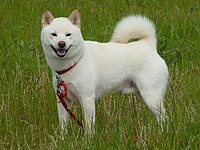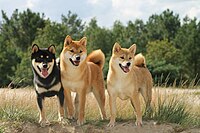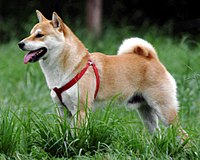Shiba Inu
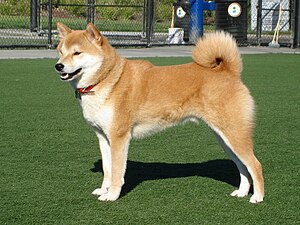 3-year-old Red Shiba Inu | |||||||||||||||||||||||||||||||||
| Other names | Japanese Shiba Inu Japanese Small Size Dog Japanese Brushwood Dog Japanese Turf Dog Shiba Ken | ||||||||||||||||||||||||||||||||
|---|---|---|---|---|---|---|---|---|---|---|---|---|---|---|---|---|---|---|---|---|---|---|---|---|---|---|---|---|---|---|---|---|---|
| Common nicknames | Shiba Shibe | ||||||||||||||||||||||||||||||||
| Origin | Japan | ||||||||||||||||||||||||||||||||
| |||||||||||||||||||||||||||||||||
| |||||||||||||||||||||||||||||||||
| Notes | [1][2] It is similar to the Akita, though much smaller in stature. | ||||||||||||||||||||||||||||||||
| Domestic dog (Canis lupus familiaris) | |||||||||||||||||||||||||||||||||
| Shiba Inu | |||||
 "Shiba Inu" in kanji | |||||
| Japanese name | |||||
|---|---|---|---|---|---|
| Kanji | 柴犬 | ||||
| |||||
The Shiba Inu (柴犬, Japanese: [ɕiba̠ inɯ̟ᵝ]) is the smallest of the six original and distinct spitz breeds of dog native to Japan.[1]
A small, agile dog that copes very well with mountainous terrain, the Shiba Inu was originally bred for hunting.[1][2] It looks similar to and is often mistaken for other Japanese dog breeds like the Akita Inu or Hokkaido, but the Shiba Inu is a different breed with a distinct blood line, temperament and smaller size than other Japanese dog breeds.[3][4][5]
Etymology[edit]

Inu is the Japanese word for dog, but the origin of the prefix "Shiba" is less clear. The word shiba means "brushwood" in Japanese, and refers to a type of tree or shrub whose leaves turn red in the fall.[6] This leads some to believe that the Shiba was named with this in mind, either because the dogs were used to hunt in wild shrubs, or because the most common color of the Shiba Inu is a red color similar to that of the shrubs. However, in an old Nagano dialect, the word shiba also had the meaning of "small", thus this might be a reference to the dog's diminutive stature.[6] Therefore, the Shiba Inu is sometimes translated as "Little Brushwood Dog".[1]
Description[edit]

Appearance[edit]
The Shiba's frame is compact with well-developed muscles.[7] Males are 35 to 43 cm (14 to 17 in) at the withers. Females are 33 to 41 cm (13 to 16 in). The preferred size is the middle of the range for each sex. Average weight at preferred size is approximately 10.5 kg (23 lb) for males, 8 kg (18 lb) for females. Bones are moderate.
The Shiba is double coated, with the outer coat being stiff and straight and the undercoat soft and thick. Fur is short and even on the fox-like face, ears, and legs. Guard hairs stand off the body and are about 4 to 5 cm (1 1⁄2 to 2 in) long at the withers. The purpose of the guard hairs is to protect their underlying skin and to repel rain or snow. Tail hair is slightly longer and stands open in a brush. Their tails are a defining characteristic and makes them stand apart from other dog breeds. Their tails help to protect them from the harsh winter weather. When they sleep, Shiba Inus curl up and use their tails to shield their face and nose in order to protect their sensitive areas from the cold.[citation needed] Shibas may be red, black and tan, or sesame (red with black-tipped hairs),[7] with a cream, buff, or grey undercoat. They may also be white (cream), though this color is considered a "major fault" by the American Kennel Club and should never be intentionally bred in a show dog, as the required markings known as "urajiro" (裏白) are not visible; "Urajiro" literally translates to "underside white".[2] Conversely, a white (cream) coat is perfectly acceptable according to the British Kennel Club breed standard.[8]
The urajiro (cream to white ventral color) is required in the following areas on all coat colors: on the sides of the muzzle, on the cheeks, inside the ears, on the underjaw and upper throat inside of legs, on the abdomen, around the vent and the ventral side of the tail. On reds: commonly on the throat, forechest, and chest. On blacks and sesames: commonly as a triangular mark on both sides of the forechest.[9]
Temperament[edit]

Shibas tend to exhibit an independent nature[7] and sometimes show aggression. This is more prevalent among female Shibas and is influenced by the breed's strong prey drive. The Shiba Inu is best in a home without other small dogs or young children, but consistent obedience training and early socialization can make all the difference. The breed also interacts fairly well with cats.[2]
From the Japanese breed standard:
A spirited boldness, a good nature, and an unaffected forthrightness, which together yield dignity and natural beauty. The Shiba has an independent nature and can be reserved toward strangers but is loyal and affectionate to those who earn his respect. They can be aggressive toward other dogs.
The terms "spirited boldness" (悍威 kan'i), "good nature" (良性 ryōsei), and "artlessness" (素朴 soboku) have subtle interpretations that have been the subject of much commentary.[10]
The Shiba is a relatively fastidious breed and feels the need to maintain itself in a clean state. They can often be seen licking their paws and legs, much like a cat. They generally go out of their way to keep their coats clean. Because of their fastidious and proud nature, Shiba puppies are easy to housebreak and in many cases will housebreak themselves. Having their owner simply place them outside after meal times and naps is generally enough to teach the Shiba the appropriate method of toileting.[11]
A distinguishing characteristic of the breed is the so-called "shiba scream". When sufficiently provoked or unhappy, the dog will produce a loud, high pitched scream. This can occur when attempting to handle the dog in a way that it deems unacceptable.[1][12][13] The animal may also emit a very similar sound during periods of great joy, such as the return of the owner after an extended absence, or the arrival of a favored human guest.
History[edit]
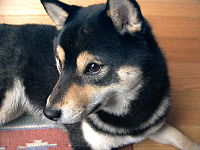
The Shiba Inu has been identified as a basal breed that predates the emergence of the modern breeds in the 19th Century.[14]
Originally, the Shiba Inu was bred to hunt and flush small game, such as birds and rabbit. Shiba lived in the mountainous areas of the Chūbu region. During the Meiji Restoration, western dog breeds were imported and crosses between these and native Japanese breeds became popular. From 1912 to 1926, almost no pure Shiba remained. From around 1928, hunters and intellectuals began to show interest in the protection of the remaining pure Shiba;[15] however, despite efforts to preserve the breed, the Shiba nearly became extinct during World War II[7] due to a combination of food shortage and a post-war distemper epidemic.[1] All subsequent dogs were bred from the only three surviving bloodlines.[16] These bloodlines were the Shinshu Shiba from Nagano Prefecture, the Mino Shiba from the former Mino Province in the south of present-day Gifu Prefecture, and the San'in Shiba from Tottori and Shimane Prefectures.[6] The Shinshu Shibas possessed a solid undercoat, with a dense layer of guard-hairs, and were small and red in color.
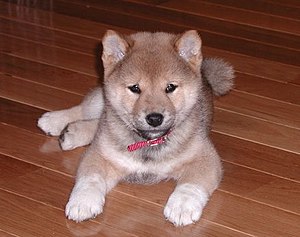
The Mino Shibas tended to have thick, prick ears, and possessed a sickle tail, rather than the common curled tail found on most modern Shibas. The San'in Shibas were larger than most modern shibas, and tended to be black, without the common tan and white accents found on modern black-and-tan shibas.[6] When the study of Japanese dogs was formalized in the early and mid-20th century, these three strains were combined into one overall breed, the Shiba Inu.[6] The first Japanese breed standard for the Shiba, the Nippo Standard, was published in 1934. In December 1936, the Shiba Inu was recognized as a Natural Monument of Japan through the Cultural Properties Act, largely due to the efforts of Nippo (Nihon Ken Hozonkai), the Association for the Preservation of the Japanese Dog.[6][17]
In 1954, an armed service family brought the first Shiba Inu to the United States.[16] In 1979, the first recorded litter was born in the United States.[16] The Shiba was recognized by the American Kennel Club in 1992 and added to the AKC Non-Sporting Group in 1993.[1][18] It is now primarily kept as a pet both in Japan and abroad.[19] According to the American Kennel Club, the Shiba Inu is the number one companion dog in Japan. In the United States, the growing popularity of the Shiba Inu is evident as the American Kennel Club Registration Statistics ranked the breed in 44th place in 2016; a rise from 50th place in 2012.[20]
Health[edit]
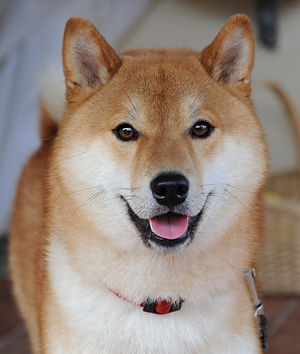
Overall, the Shiba Inu is a healthy dog breed.[21][22][23][24] Health conditions known to affect this breed are allergies, glaucoma, cataracts, hip dysplasia, entropion, and luxating patella.[25] Periodic joint examinations are recommended throughout the dogs life. Eye tests should be performed yearly as eye problems can develop over time. By two years of age, Shiba Inus can be considered fully free from joint problems, if none have been discovered, since at this age the skeleton is fully developed.
As with any dog, Shibas should be walked or otherwise exercised daily.[26]
Life span[edit]
Their average life expectancy is from 12 to 15 years. Exercise, especially daily walks, is preferred for this breed to live a long and healthy life.[16] The oldest known Shiba, Pusuke, died at age 26 in early December 2011. Pusuke was the oldest dog alive at the time and lived three years less than the world record for longest living dog.
Grooming[edit]
These low maintenance dogs[27] are very clean, so grooming needs will likely be minimal. A Shiba Inu's coat is coarse; short to medium length with the outer coat being 2.5 to 3.2 cm (1 to 1 1⁄4 in) long, and is naturally waterproof so there is little need for regular bathing. They also have a thick undercoat that can protect them from temperatures well below freezing. However, shedding, also known as blowing coat, can be a nuisance. Shedding is heaviest during the seasonal change and particularly during the summer season, but daily brushing can temper this problem. It is recommended that owners never shave or cut the coat of a Shiba Inu, as the coat is needed to protect them from both cold and hot temperatures.[28]
- Shiba Inu
-
A cream coated Shiba Inu
-
Two red with a black and tan Shiba Inus
-
A red Shiba Inu
-
Red Shiba Inu Puppy
See also[edit]
Some use of "" in your query was not closed by a matching "".Some use of "" in your query was not closed by a matching "".
- Doge (meme)
- Mameshiba
- Dogecoin, which features a likeness of the breed.
- Japan Kennel Club
- Shiba Inu Puppy Cam
References[edit]
- ↑ 1.0 1.1 1.2 1.3 1.4 1.5 1.6 "Dog Owners Guide: Shiba Inu". Retrieved August 20, 2007.
- ↑ 2.0 2.1 2.2 2.3 "Shiba Inu Breed Standard". American Kennel Club. Retrieved August 20, 2007.
- ↑ "Japanese Kennel Club Classification". Jkc.or.jp. Retrieved 1 July 2014.
- ↑ "Shiba inu". Japanesedog.org. Retrieved 1 July 2014.
- ↑ Parker, Heidi G.; Kim, Lisa V.; Sutter, Nathan B.; Carlson, Scott; Lorentzen, Travis D.; Malek, Tiffany B.; Johnson, Gary S.; DeFrance, Hawkins B.; Ostrander, Elaine A.; Kruglyak, Leonid (2004-05-21). "Genetic Structure of the Purebred Domestic Dog" (PDF). Science. 304 (5674): 1160–4. doi:10.1126/science.1097406. PMID 15155949.
- ↑ 6.0 6.1 6.2 6.3 6.4 6.5 Haskett, Gretchen; Houser, Susan (1997). The Total Shiba. Loveland, CO: Alpine Publications. ISBN 1-57779-049-9. Search this book on

- ↑ 7.0 7.1 7.2 7.3 "Get to Know the Shiba Inu", 'The American Kennel Club', retrieved 14 May 2014
- ↑ "Japanese Shiba Inu Breed Standard". The Kennel Club Limited. Retrieved November 16, 2012.
- ↑ "NSCA: Urajiro". Retrieved August 23, 2007.
- ↑ Miriam Clews (Ed.). The Japanese Shiba Inu: A detailed study of the Shiba.
- ↑ "An Introduction to the Shiba Inu (part 2)". Retrieved August 20, 2007.
- ↑ "Shiba Inu Traits". Archived from the original on August 10, 2007. Retrieved August 20, 2007.
- ↑ "The Misanthropic Shiba". Retrieved August 21, 2007.
- ↑ Larson, G (2012). "Rethinking dog domestication by integrating genetics, archeology, and biogeography". Proc. Natl. Acad. Sci. U.S.A. 109: 8878–83. Bibcode:2012PNAS..109.8878L. doi:10.1073/pnas.1203005109. PMC 3384140. PMID 22615366.
- ↑ "世界の犬 : 5G 原始的な犬・スピッツ : し : 柴 - SHIBA" [World dogs: 5G primitive dog · Spitz: Shi: Shiba - SHIBA]. www.jkc.or.jp (in Japanese). Retrieved May 16, 2018.CS1 maint: Unrecognized language (link)
- ↑ 16.0 16.1 16.2 16.3 "Shiba Inu Dog Breeds". Retrieved August 20, 2007.
- ↑ Atkinson, Maureen (1998). The Complete Shiba Inu. Howell Book House. p. 11. ISBN 0-87605-177-8. Search this book on

- ↑ Club, American Kennel. "Shiba Inu Dog Breed Information".
- ↑ Holden, Jacey. "Shiba Inus". Retrieved August 23, 2007.
- ↑ American Kennel Club 2013 Dog Registration Statistics Historical Comparisons & Notable Trends, The American Kennel Club, Retrieved 17 February 2018
- ↑ "Shiba Inu". dogtime.com. Retrieved 1 June 2014.
- ↑ "The Shiba Inu". smalldogplace.com. Retrieved 1 June 2014.
- ↑ "Shiba Inu". pikimal.com. Retrieved 1 June 2014.
- ↑ "About the Shiba Inu". dogs.lovetoknow.com. Retrieved 1 June 2014.
- ↑ Holden, Jacey. "An Overview of Health Problems in the Shiba Inu". Retrieved August 20, 2007.
- ↑ "Get to Know the Shiba Inu", 'The American Kennel Club', retrieved 13 May 2014
- ↑ "Low Maintenance Dogs". Retrieved 1 March 2016.
- ↑ "Shiba Inu Training - Grooming". Retrieved 1 March 2013.
External links[edit]
| Wikimedia Commons has media related to Shiba Inu. |
This article "Shiba Inu" is from Wikipedia. The list of its authors can be seen in its historical. Articles copied from Draft Namespace on Wikipedia could be seen on the Draft Namespace of Wikipedia and not main one.

